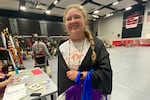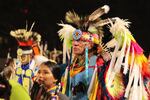Western Oregon University junior Jaylin Hardin, a member of the Cow Creek Band of Umpqua Tribe of Indians, has federal financial aid and local scholarships that help pay for college.
“I have a merit-based scholarship from my university, I have the Pell Grant and I have a memorial scholarship I received from Josephine County,” the 21-year-old Hardin said. “I received those, but they just weren’t enough to pay for my degree.”

Western Oregon University Junior Jaylin Hardin celebrates her Indigenous heritage at a Pow Wow hosted by the school's Multicultural Student Union on April 19, 2025. Hardin is a member of the Cow Creek Band of Umpqua Tribe of Indians.
Courtesy of Jaylin Hardin
Hardin is studying to become an early childhood teacher, a career she’s known she wanted to get into since middle school. Her first year at college, Hardin took out about $12,000 in student loans to cover the remaining costs to attend Western.
But Hardin’s student loan debt hasn’t grown since then. That’s because awards from the Oregon Tribal Student Grant have been filling in the gap since her sophomore year. Hardin said the grant is one the best resources available to tribal members, and will help her into the future.
“There will be less stress and burden when I enter teaching because I’m not going to have to pay off as much on student loans,” Hardin said. “And currently I don’t have to worry about taking from my income to pay for textbooks for the term.”
The Oregon Tribal Student Grant is designed to help a student demographic that has been historically underrepresented in colleges and universities in the U.S. And state officials are hoping to grow the program, even as higher education institutions face unprecedented federal pressures to ban diversity initiatives.
Related: College tuition breaks for Native American students spread, but some tribes are left out
Officials in Oregon have pushed back on federal actions — through written statements, court filings and by continuing to press ahead with education priorities that preceded the Trump administration.
And as interest in the grant to support Indigenous students continues to build, tribal education leaders throughout the state say it’s been transformative for many of its members.
“It’s opened up a lot of opportunities for students who are realizing they don’t have to take out a bunch of loans [to attend college],” said Jemiah Wassman, director of education for the Confederated Tribes of Coos, Lower Umpqua and Siuslaw Indians.
American Indigenous and Alaska Native students have the lowest college-going rate, 25%, of any racial or ethnic group in the U.S., according to the National Center for Education Statistics.

Native American and Indigenous dancers pack an arena during a grand entry procession at the annual Gathering of Nations powwow in Albuquerque, New Mexico, Friday, April 25, 2025. The Oregon Tribal Student Grant supports Indigenous students, expanding opportunities despite federal pushback against diversity efforts, and has been transformative for many amid historically low college-going rates.
Susan Montoya Bryan / AP
Wassman said education from birth to adulthood has always been a high priority for tribal leadership. But the price tag of college — which includes costs beyond tuition like housing, food and transportation expenses — is often a financial barrier for many families. The tribal grant is beginning to tear that barrier down, providing funds for students to pay for those other college-related costs.
“The immediate impact that I see is that we had 26 more enrollees from last year to this year receive the grant,” Wassman said. “That’s significant — that’s a 57% increase in one year.”
Eligibility requirements for the grant are simple: Students must be enrolled members of any of the state’s nine federally-recognized tribes, attend a college or university in Oregon and be working towards an associate, bachelor’s or graduate degree. Oregon’s Higher Education Coordinating Commission administers the grant. Currently, the program is not offered to Indigenous students in tribes not recognized by the federal government.
So far, the grant has shown many signs of success.
HECC awarded 616 tribal grants to students this school year, up from 501 last school year and 412 in the grants first year. Over 200 tribal members who have received the grant have gone on to earn degrees, according to the agency.
A HECC analysis also shows that freshman grantees attending a university are more likely to return to school the following year than students who are not awarded the grant.
The agency says demand for the $24 million program is increasing. And with many federal funding avenues threatened under the current federal administration, that demand could grow further.
Related: First Nations Student Union club creates space of belonging at Central Oregon Community College
In February, the U.S. Department of Education issued a “Dear Colleague” letter ordering higher education institutions to stop all diversity, equity, inclusion and race-based programs or risk losing federal funding. The federal policy is currently facing multiple legal challenges in court.
The Education Department has also frozen applications for the Native American Career and Technical Education Program, a federal grant that provides millions of dollars of financial aid to Indigenous students annually. These moves come despite a federal law, upheld by the Supreme Court in 1974, that defines tribes as government entities rather than racial groups.

FILE - President Donald Trump holds up a signed executive order alongside Secretary of Education Linda McMahon in the East Room of the White House in Washington, Thursday, March 20, 2025.
Ben Curtis / AP
A spokesperson with HECC said the tribal grant is state-funded and any recent federal changes would have no impact on the program. Gov. Tina Kotek’s budget for the next biennium recommends expanding the grant with an additional $2.5 million.
“Since the onset of the grant, we’ve seen a lot of our students return to school because with that extra assistance they can finish up their degrees,” said Angela Fasana, education department manager for the Confederated Tribes of Grand Ronde.
More than a quarter of all completed tribal grant applications for this current school year came from Grand Ronde members, according to HECC. Fasana’s relatives, including her son, who attends Oregon State University, as have received the grant.
Fasana said many members are applying the knowledge they gathered in college back toward their tribal community.
“There’s a large sector of our tribal government employees that have returned to school to further their education in the fields they’re already working in here at the tribe,” Fasana said. “So it’s been really great for professional development.”
Related: Oregon colleges and universities are not wavering amid federal attacks on DEI
Mark Petrie, a citizen of the Confederated Tribes of Coos, Lower Umpqua and Siuslaw Indians, used the tribal grant in a similar fashion. Petrie had been a community builder within his tribe for a decade before he decided to return to pursue a bachelor’s degree in social work at Portland State University in 2022. Petrie graduated last year with no student loan debt.
“That’s solely due to the tribal grant,” Petrie said. “It’s just amazing. I feel very fortunate, very lucky and privileged to have this resource.”
Now Petrie is looking to complete a master’s degree in social work at PSU. He plans to apply for the tribal grant again for his graduate degree. Ultimately, Petrie hopes to bring more mental and behavioral health care to tribal members.
“Cultural practices really inform my pathway forward and the passion I have for the work is grounded and rooted in the Indigenous teachings of this area,” Petrie said. “I really want to find a way to build programs and create more access to mental health support systems in my community.”
And Oregon’s tribal education leaders say this grant does more than just benefit Indigenous communities. Grand Ronde’s Fasana said tribal members can bring a richer experience to students and faculty at Oregon’s colleges and universities by broadening their cultural horizons.
“We were the first doctors, we were the first teachers, we were the first foresters here in Oregon, our ancestral homeland,” Fasana said. “So we get an opportunity to share some of our cultural knowledge when we move into higher education spaces.”
